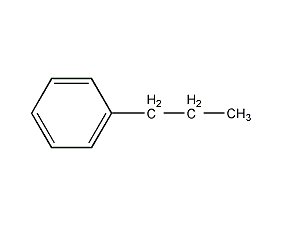
Structural formula
| Business number | 02NY |
|---|---|
| Molecular formula | C9H12 |
| Molecular weight | 120.19 |
| label |
1-phenylpropane, propylbenzene, 1-Phenylpropane, Propylbenzene, Cellulose acetate solvent, hydrocarbon solvents, For organic synthesis |
Numbering system
CAS number:103-65-1
MDL number:MFCD00009377
EINECS number:203-132-9
RTECS number:DA8750000
BRN number:1903006
PubChem number:24887947
Physical property data
1. Properties: colorless and transparent liquid[1]
2. Melting point (℃): -99.5[2]
3. Boiling point (℃): 159.2[3]
4. Relative density (water=1): 0.862[4]
5. Relative vapor density (air=1): 4.14[5]
6. Saturated vapor pressure (kPa): 0.33 (20℃) [6]
7. Heat of combustion (kJ/mol): -5209.9[7]
8. Critical temperature (℃): 365.6[8]
9. Critical pressure (MPa): 3.24[9]
10. Flash point (℃): 30 (CC) [10]
11. Ignition temperature (℃): 450[11]
12. Explosion upper limit (%): 6.0[12]
13. Explosion lower limit (%): 0.8[13]
14. Solubility: Insoluble in water, miscible in most organic solvents such as ethanol, ether, acetone and so on. [14]
15. Relative density (25℃, 4℃): 0.8579
16. Refractive index at room temperature (n25): 1.4895
17. Critical density (g·cm-3): 0.273
18. Critical volume (cm3·mol-1): 440
19. Critical compression factor: 0.265
20. Eccentricity factor: 0.346
21. Solubility parameter (J·cm-3)0.5: 17.805
22. van der Waals area (cm2·mol-1): 1.012×1010
23. van der Waals volume (cm3 ·mol-1): 79.970
24. Gas phase standard combustion heat (enthalpy) (kJ·mol-1): -5264.48
25. Gas phase standard claimed heat (enthalpy) (kJ·mol-1): 7.91
26. Gas phase standard entropy (J·mol-1 ·K-1): 398.19
27. Gas phase standard free energy of formation (kJ·mol-1): 138.16 p>
28. Gas phase standard hot melt (J·mol-1·K-1): 146.90
29. Liquid phase standard Heat of combustion (enthalpy) (kJ·mol-1): -5218.24
30. Liquid phase standard claims heat (enthalpy) (kJ·mol-1 sup>): -38.33
31. Liquid phase standard entropy (J·mol-1·K-1): 287.78
32. Liquid phase standard free energy of formation (kJ·mol-1): 124.85
33. Liquid phase standard hot melt (J·mol-1 ·K-1): 214.72
Toxicological data
1. Acute toxicity[15]
LD50: 6040mg/kg (rat oral)
LC50 ���319150mg/m3 (rat inhalation, 2h)
2. Irritation No information available
Ecological data
1. Ecotoxicity[16]
IC50: 2mg/L (24h) (Daphnia)
LC50: 1.5mg/L (4d) (rainbow trout)
2. Biodegradability No data available
3. Non-biodegradability [17] In the air, when the concentration of hydroxyl radicals is 5.00×105 pieces/cm3, the degradation half-life is 2d(theory).
4. Bioaccumulation [18] BCF: 138 (theoretical)
5. Other harmful Effect[19] This substance may be harmful to the environment, and special attention should be paid to aquatic life and birds. Bioaccumulates in mammals.
Molecular structure data
1. Molar refractive index: 40.43
2. Molar volume (cm3/mol): 138.7
3. Isotonic specific volume (90.2K ): 323.6
4. Surface tension (dyne/cm): 29.6
5. Dielectric constant: 2.33
6. Dipole moment (10-24cm3):
7. Polarizability: 16.02
Compute chemical data
1. Reference value for hydrophobic parameter calculation (XlogP): None
2. Number of hydrogen bond donors: 0
3. Number of hydrogen bond acceptors: 0
4. Number of rotatable chemical bonds: 2
5. Number of tautomers: none
6. Topological molecule polar surface area 0
7. Number of heavy atoms: 9
8. Surface charge: 0
9. Complexity: 60.4
10. Number of isotope atoms: 0
11. Determine the number of atomic stereocenters: 0
12. Uncertain number of atomic stereocenters: 0
13. Determine the number of chemical bond stereocenters: 0
14. Number of uncertain chemical bond stereocenters: 0
15. Number of covalent bond units: 1
Properties and stability
1. Stability[20] Stable
2. Incompatible substances[21] Strong oxidants, acids, halogens, etc.
3. Polymerization hazards[22] No polymerization
Storage method
Storage Precautions[23] Store in a cool, ventilated warehouse. Keep away from fire and heat sources. The storage temperature should not exceed 37°C. Keep container tightly sealed. should be kept away from oxidizer, do not store together. Use explosion-proof lighting and ventilation facilities. It is prohibited to use mechanical equipment and tools that are prone to sparks. The storage area should be equipped with emergency release equipment and suitable containment materials.
Synthesis method
1. Prepared by the action of diisoester sulfate and benzyl magnesium chloride.
Purpose
1. Used as textile dye and printing, and as acetate fiber solvent.
2. Used as solvent and organic synthesis. [24]


